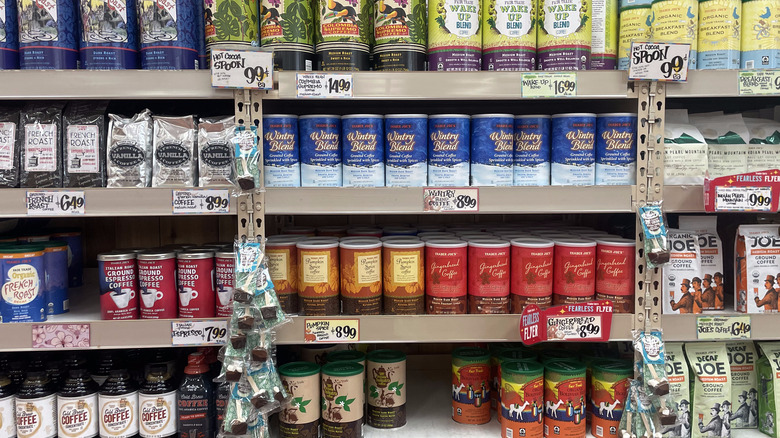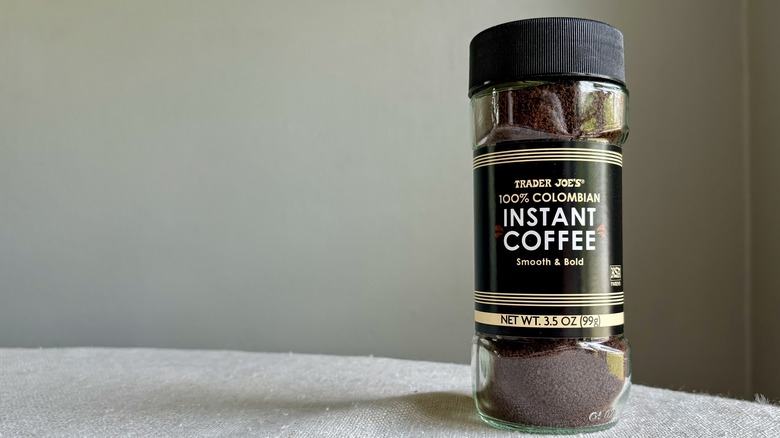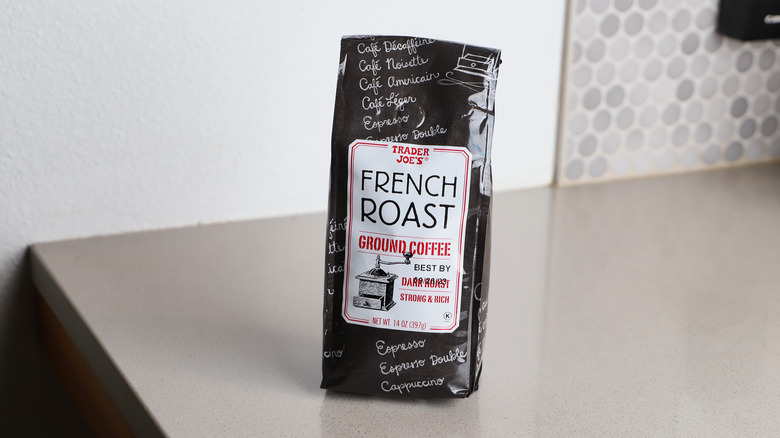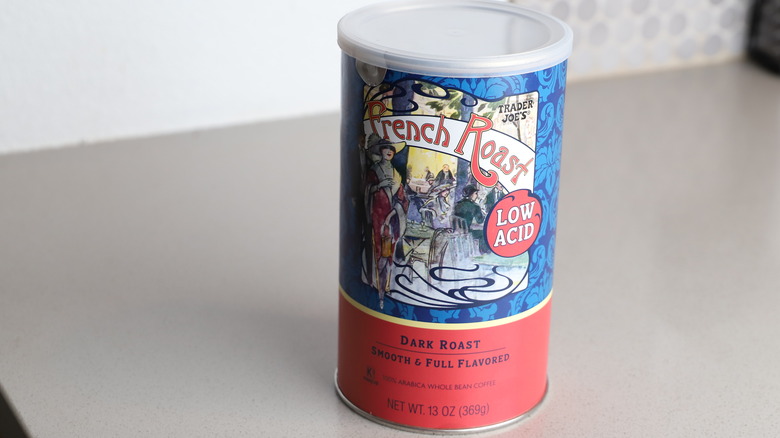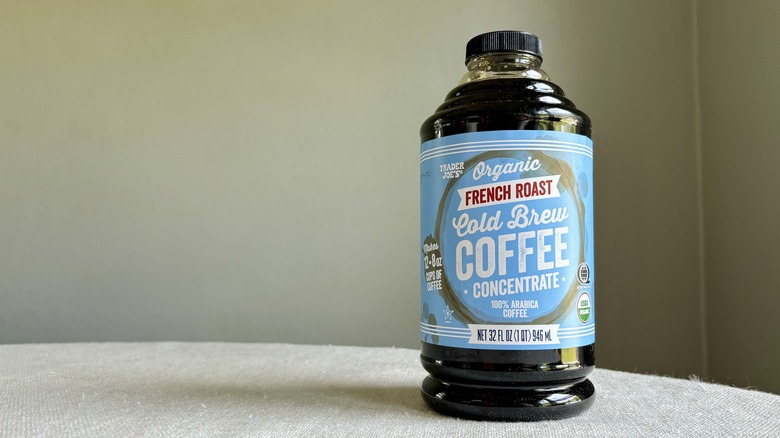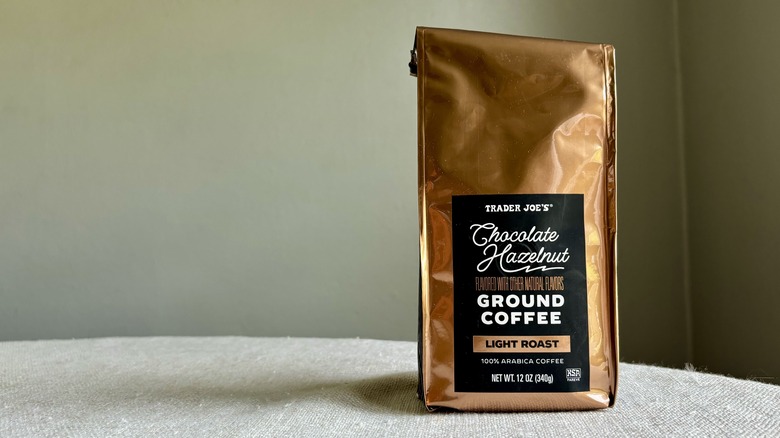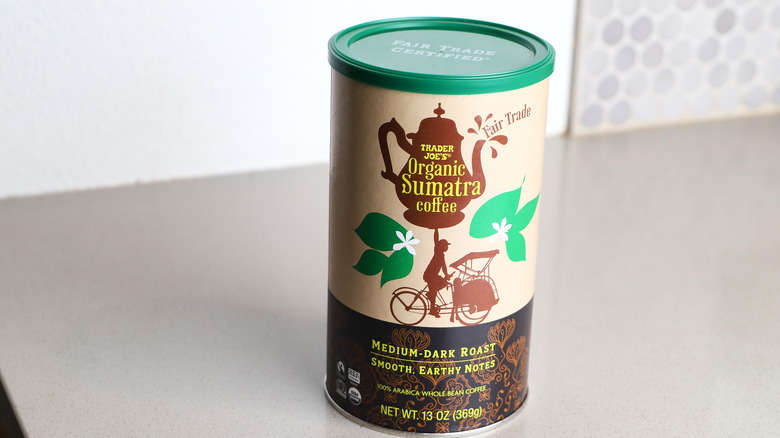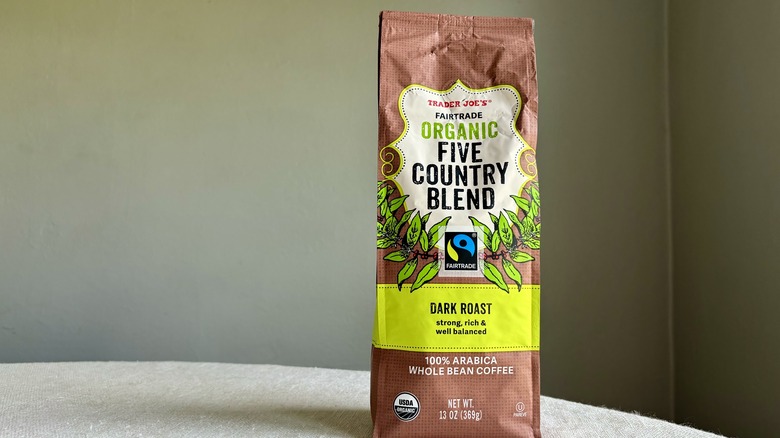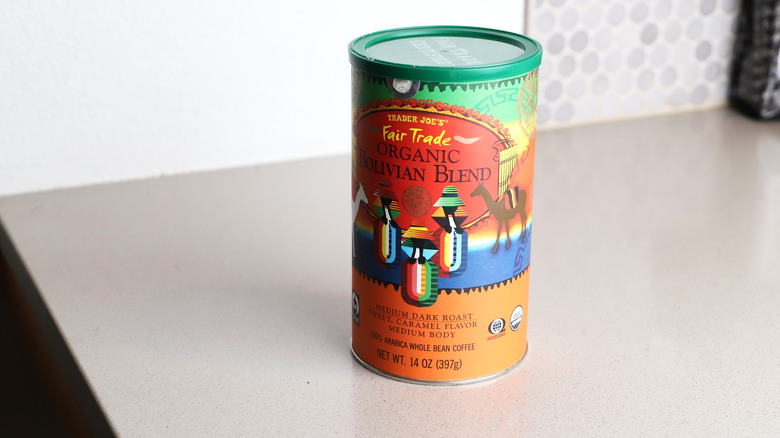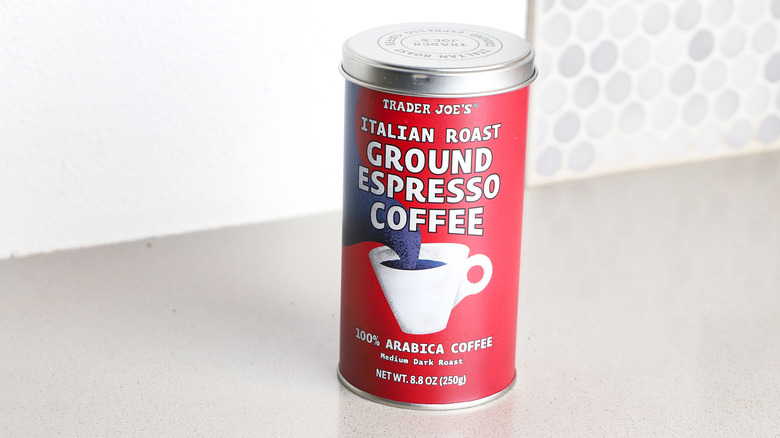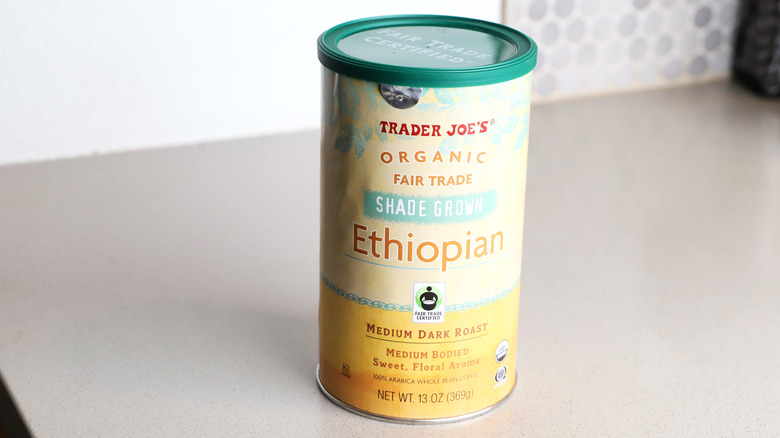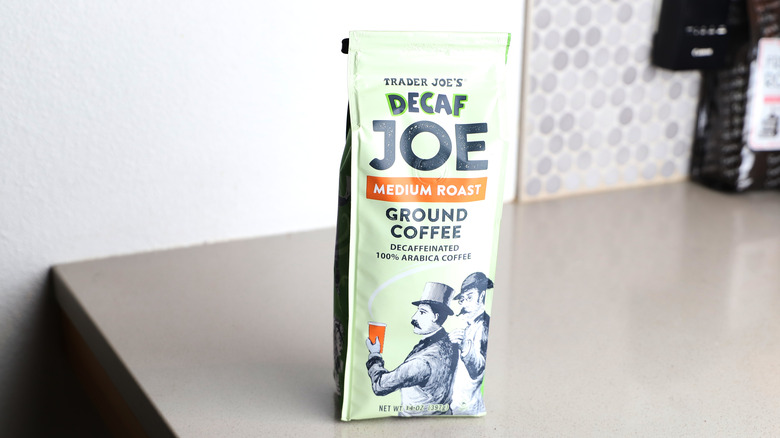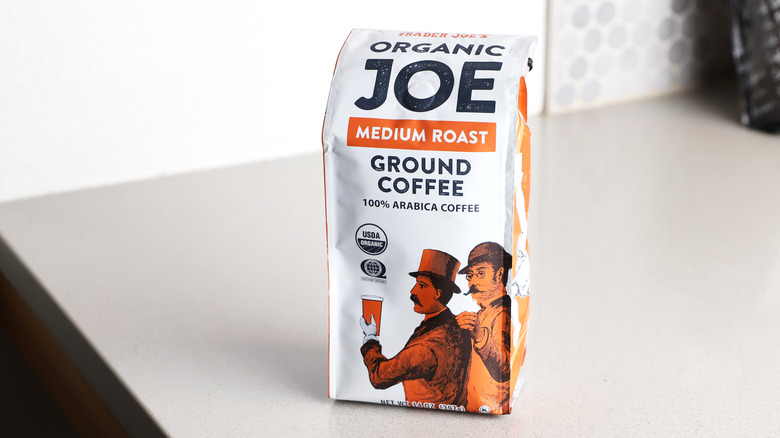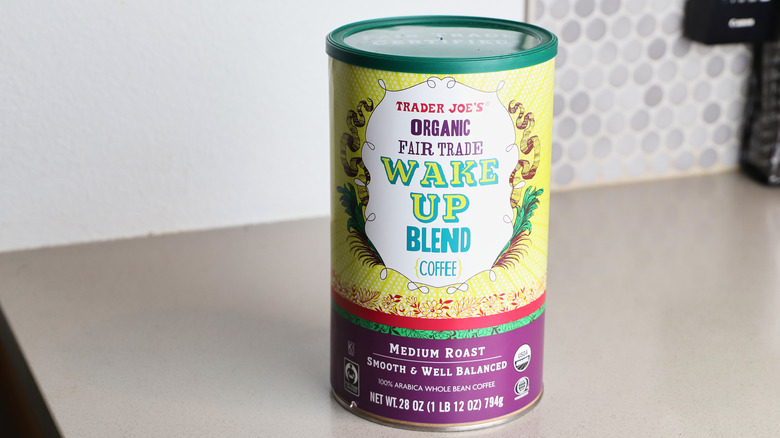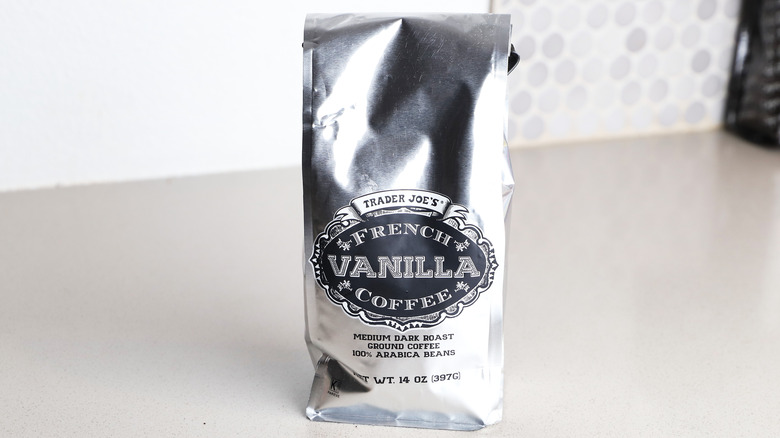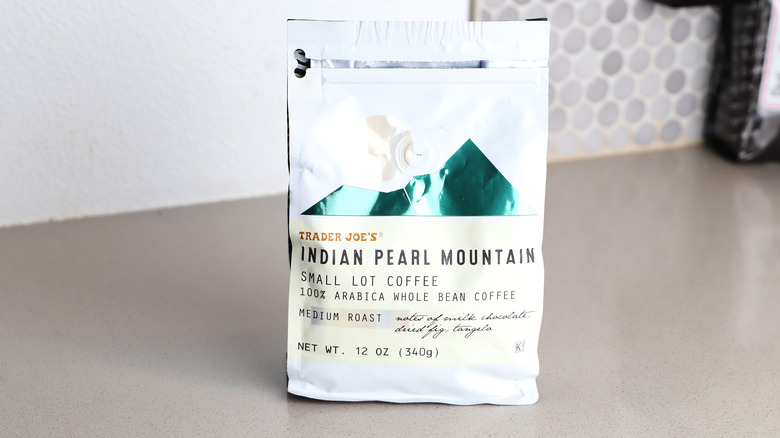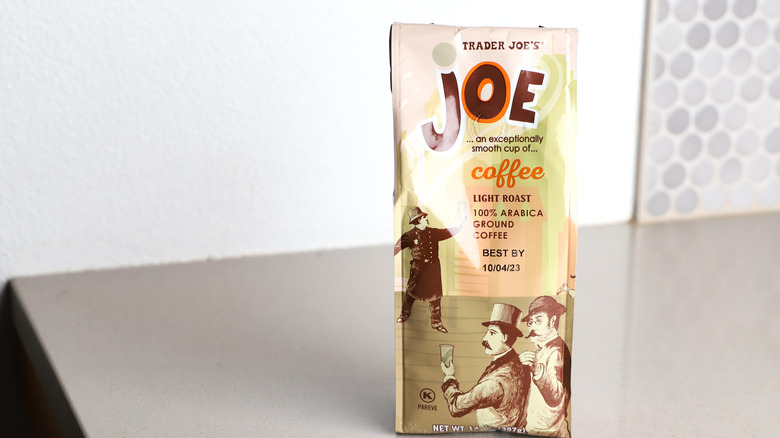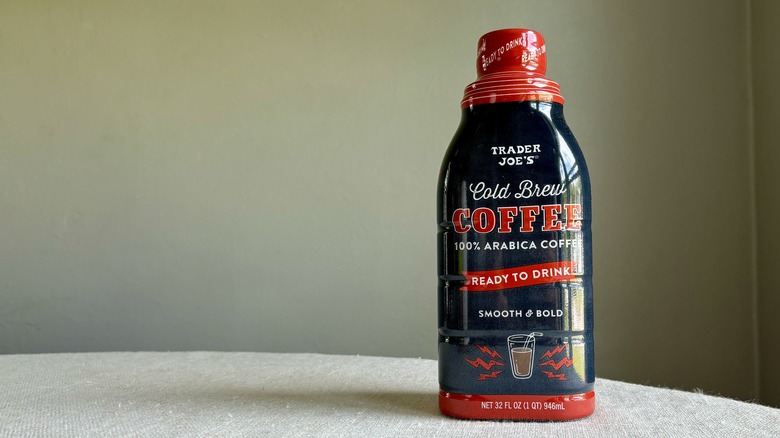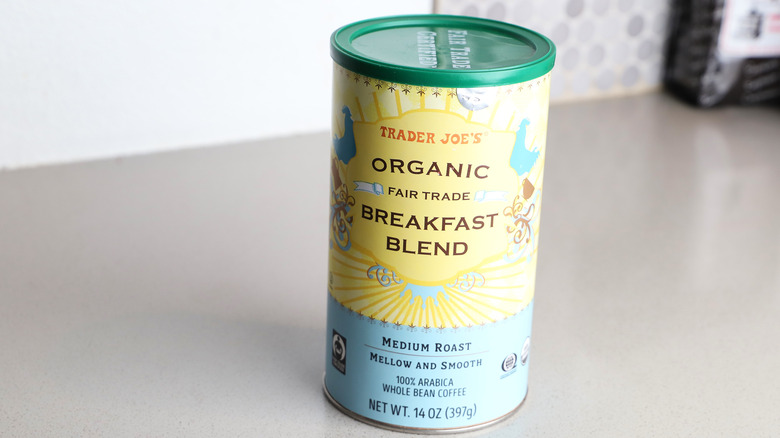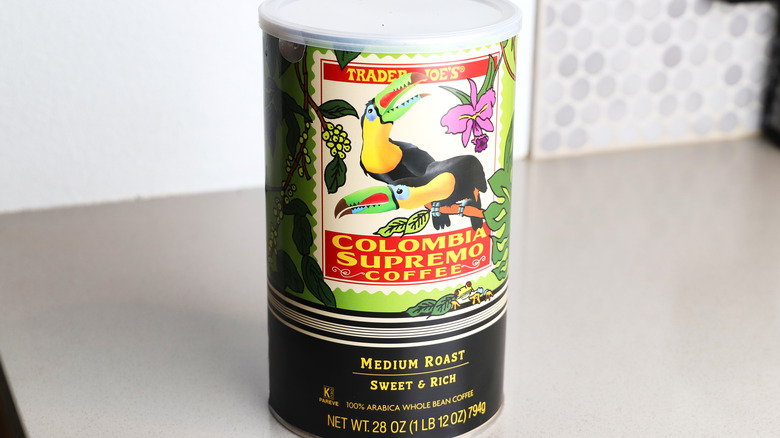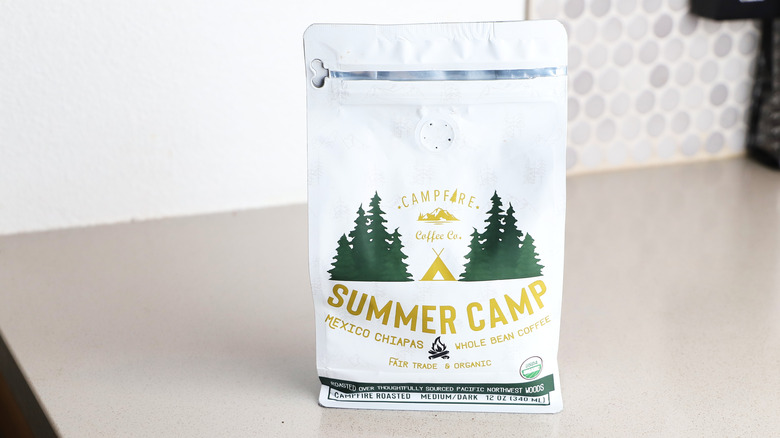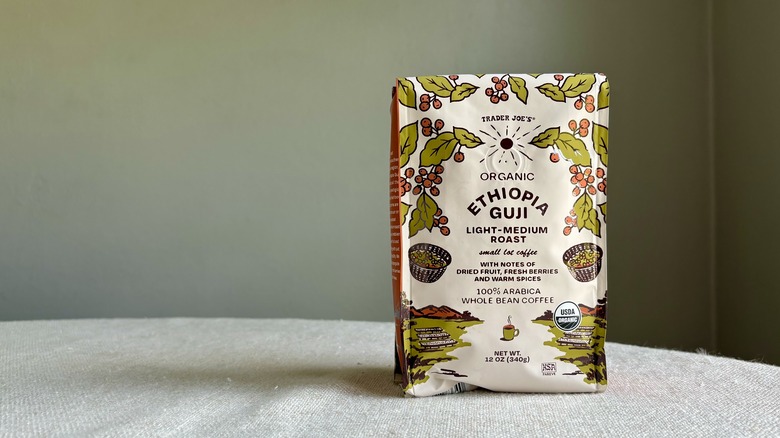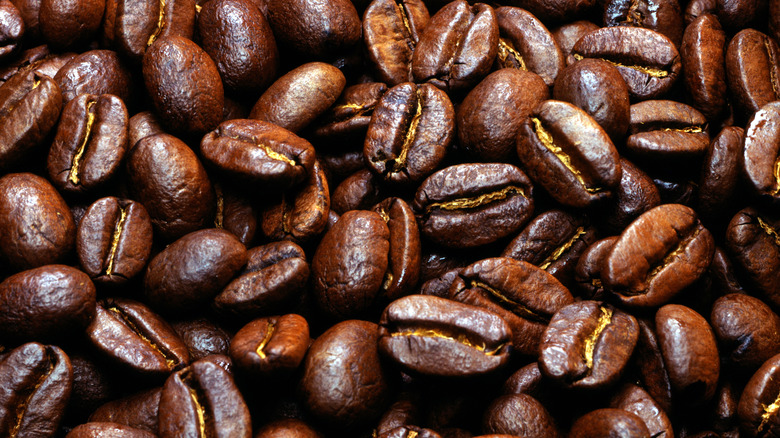23 Trader Joe's Coffee, Ranked Worst To Best
Trader Joe's may be best known for its extensive frozen food section and affordable wine and cheese offerings. However, its growing aisle of coffees has remained an under-the-radar selection, perhaps due to the sometimes inscrutable variables between beans.
With coffees spanning several roasts, origins, and even flavoring, the Trader Joe's coffee collection occupies a substantial strip of each store's real estate. And though the chain brought back the pre-pandemic tradition of storewide sanctioned sampling and pairing, the coffee stations located in the rear of each TJ's remain silent as of late 2022. Until that changes, taking home a pound (or two) of their various coffees is the only way to test drive the dizzying amount of coffee options the store offers.
To give you a head start, we piled an armload of Trader Joe's year-round coffee selections (they also offer pumpkin spice and gingerbread-infused grounds during the holiday seasons) into our red plastic carts. Taking them all home to make our daily pour-overs, we tested the best and worst of Trader Joe's disparate coffee options for you. In the way of coffee beans, we bought everything we could find in whole bean format and ground those coarsely in a burr grinder to make a one-serving French press. For the pre-ground stuff, we made a single-cup pot of each in a drip brewer. The pre-made cold brews were both poured over ice and finally, the one instant coffee we tried was made according to the bottle's instructions.
23. Colombian Instant Coffee
Before we get into our unabashed lament on this instant coffee, let's first say this: It's hard to put instant coffee up against regular coffee beans. That's because instant coffee undergoes a ton of processing, including dehydration by freeze-drying or spray-drying. The processing significantly affects the flavor nuances of coffee beans for the sake of convenience, so it ends up tasting much different than a fresh-brewed cup made with freshly ground beans.
Trader Joe's Colombian Instant Coffee is no different. Unless you are going camping or putting yourself into a situation that seriously inhibits you from making (or buying) a good cup of coffee, stray away from this stuff. We made this instant coffee according to the package instructions — 1 heaping teaspoon per cup of hot water — and were disappointed from the first sip. There's virtually no flavor present except bitter, so it tastes as though some bitter chemical was steeped in the water rather than coffee. This just won't do — it's about as undrinkable as it gets. Avoid.
22. French Roast (ground)
We don't know who the intended audience is for Trader Joe's French Roast. A cup of this ground coffee brews so densely it looks like a vat of paint while sitting in a mug. On the tongue, it crashes onto the palate, shatters any potential to enjoy a relaxing morning routine, and tastes and smells like an old cigar box.
Thick and menthol-like, we're guessing French Roast ground's core audience is folks who take their coffee with not only a dollop of cream and sugar but a heaping glug of flavorings, whip, and even sprinkles. To say this is by far Trader Joe's worst offender doesn't fully encapsulate how dismal it is. If you dare take a bag home, also grab a case of Trader Joe's Sparkling Water to cleanse your palate.
21. French Roast (whole bean)
While we've never been devotees of dark roasted coffee, we can sip on a short pour of French roast every now and then (usually post dessert). However, the whole bean version of Trader Joe's French Roast thoroughly misses its target in every regard. The gleam of oil tarping each bean shines so prominently that they catch the light, not unlike greasy diamonds.
Once brewed, the beans keep their promise and result in a bitter, unpalatable boldness. It wipes out any subtle dimensions the beans might have once possessed and simultaneously detracts from any food you might be trying to enjoy alongside your cup of morning coffee. Furthermore, once we put down our mug for a brief reprieve, the surface of the liquid became home to the oily gunk we took note of before brewing.
20. Organic French Roast Cold Brew Coffee Concentrate
Believe us when we say: We were really, really rooting for this cold brew concentrate to knock our socks off. We wanted it to be the perfect solution to our lazy, cold-brew-making-averse selves. But sadly, she disappointed.
The thing we liked the least about this concentrate was how difficult it was to find a balance. The bottle recommends mixing one part concentrate with two parts water or milk. But upon following these directions, we found every time — regardless of the liquid used to dilute — that the coffee was way too weak. Not only was it not strong enough, but it was almost devoid of flavor, despite of the concentrate's French roast darkness. After a few cups, we decided that a ratio of 2:1 coffee to water was much better, but even then, still a little weak. That leads us to believe that this is a pretty weak concentrate and easy to consume quite quickly. So, at that point, why wouldn't we just buy ready-to-drink cold brew?
19. Chocolate Hazelnut Coffee (ground)
While it certainly wasn't the worst coffee we drank on this list, Chocolate Hazelnut was far from the best, too. This light roast coffee comes only in pre-ground format, which in some ways was a relief — we really didn't want to run this flavored Trader Joe's coffee through our burr grinder. That said, these pre-ground beans weren't as fresh as they could be, which is to be expected of ground coffee bought in the store. The grounds smelled less of coffee than artificial hazelnut, which was the first warning sign we noticed, and the foreshadowing prevailed.
This coffee brewed fine on body, thanks to the light roast of the beans sourced from Brazil's Cerrado de Minas, but unfortunately, the flavor was completely taken over by the chocolate and hazelnut flavoring oils. We're not the most partial folks to flavored coffees, so this expectedly turned us off. We couldn't get the taste out of our mouths.
18. Organic Sumatra Coffee (whole bean)
Upon opening the tin of Organic Sumatra coffee beans, we spied red flags all over the place. The beans appear to be roasted so dark they were almost black and covered in the oily glaze we balk at. Once ground and awaiting hot water, the deep, dark grinds refuse to bloom, and the water runs too quickly through the coffee. This created an overly dark, syrupy cup that tasted solely bitter.
Even the mouthfeel of the coffee translates weighty and intrusive, yet dull. Curiously, the packaging nudges its reader to enjoy a mug of Sumatra Coffee "after a savory meal." This seems like Trader Joe's is trying to find a positive quality in a subpar can of coffee by creating a circumstance their coffee drinker would rarely find themselves in. While we admit that we're not sure if a salty meal would offset how unpalatable we find Trader Joe's Sumatra, we highly suspect the pairing advice to be a cleverly planted red herring.
17. Fair Trade Organic Five Country Blend (whole bean)
Trader Joe's Five Country Blend used to be tagged "espresso," but that's changed. The current Five Country Blend — while nearly the same coffee — is simply dark roast now, and no longer with the espresso designation on the label. While the old blend was made up of beans from El Salvador, Guatemala, Mexico, Peru, and Indonesia, the new blend is composed of Guatemalan, Indonesian, Honduran, Mexican, and Peruvian beans. In our prior list, we already weren't super pleased by this coffee, and we are unfortunately even less pleased by this new rendition.
We blitzed a French press worth in our burr grinder and got to work. This stuff is much more bitter than the espresso blend, yet not nearly as rich and full-bodied. The beans taste like they've been taken past the optimal roast point, as they're super dark and ultimately make the cup taste muddy. This one would be better left as an espresso; it's tough to drink a full helping.
16. Fair Trade Organic Bolivia Blend (whole bean)
What we first noticed about Trader Joe's Bolivia Blend was how oily the beans looked, slippery to the touch, and slightly ashy in their aroma. Sourced from several (though the bag doesn't specify) family farms "between the peak of the Andes and the Amazon Basin," the tin blends both medium and dark roasts but smells aggressively dark and brews into a deep color as well. Incredibly bitter and flat at the same time, the package boasts of a caramel note we couldn't detect over the bitter wipe-out of over-roasted beans.
Comprised entirely of the world's most grown coffee beans, Arabica, the medium to small beans are taken way past the point of being sippable. This Bolivia Blend yearns for a tablespoon or two of creamer or oat milk to mellow out the bitter, acidic taste that otherwise sticks around on your tongue long after sipping.
15. Italian Roast Ground Espresso Coffee
Packaged in a little canister to signal espresso and a shorter pour, Trader Joe's Italian Roast Ground Espresso showed little promise when we cracked open the tin merely judging by the potent, nearly burnt smell emitting from the unassuming canister. However, we can't help but grade all at-home espresso on a curve. No matter the equipment, nothing beats a well-dialed machine shot pulled by a professional barista who's been doing it all day.
So instead of attempting to recreate a barista-made espresso, we followed the instructions for a pour-over version and made a mini-sized cup of coffee. It was dark in color and free of any mile markers of distinction. The miniature cup did possess a thicker, rounder, more saline-like mouth feel along with the bitter, dense finish we've come to know from drinking the contents of a demitasse cup.
14. Joe's Dark Coffee (ground)
We have to admit that dark-roasted coffee isn't typically our thing, so we side-eyed the bag of Joe's Dark ground coffee beans as we heated up the kettle. As suspected, the grounds refused to bloom into the coffee fluff we like to see while making a pour-over coffee with our trusted Chemex, and the hot water slipped a little too quickly through the grasp of the coffee grounds.
Though our cup of this dark roast wasn't an experience we yearn to repeat, it wasn't as offensive to the taste buds as we anticipated. Smelling and tasting both extremely dark baking chocolate, the dark roast lacks dimension but boasts none of the acidic secondary notes we initially feared. With a generous helping of sugar, the edge of bitterness was massaged into an espresso-like cup of coffee that would pair well with a slice of German chocolate cake or another ultra-rich dessert.
13. Organic Fair Trade Shade Grown Ethiopian (whole bean)
The can of Shade Grown Ethiopian coffee explains its tasting notes as "sweet and floral." Still, we were unable to pick out the delicate tendencies the beans might hold because of the overpowering smell and taste. At this point, we began to wonder why Trader Joe's catalog of coffees insists on being so diverse when so many of the coffees check the same boxes but merely boast different packaging and verbiage.
The Shade Grown Ethiopian beans flaunt a slight baking spice edge (mostly cardamom). Yet, the beans tasted too weighty for their own good and left us wishing they were more lightly roasted so we could decipher some gentler notes that the shade-grown beans probably once possessed.
12. Decaf Joe Medium Roast (ground)
Somewhat of a novice to decaf coffee and its appeal, we understand the demand for a noncaffeinated coffee option from every purveyor of the real thing. From what we've (almost entirely accidentally tasted) of decaffeinated coffee in the past, Trader Joe's rendition of the ground beans are par-for-the-course. While we didn't wish to keep sipping our mug of decaf, we don't see TJ's decaf to be any more or less loathsome than the average decaf.
The taste was astringently sour on the first sip, then settled into a sharp approximation of our morning beverage of choice. That said, while brewing, the decaf ground beans give off a toasted bread aroma we appreciated in our kitchen. At the very least, this bag supplied us with a coffee-scented diffuser for the day.
11. Organic Joe Medium Roast (ground)
Organic Joe Medium Roast exists in Trader Joe's line of products wherein the grocery store opts for old-timey illustrations of bespectacled and top-hat-adorned men to decorate the packaging. While we root for the brand to reimagine this visual representation of its products, we also have to admit many of these items are among our favorites, including the Unexpected Cheddar Cheese Spread.
Preground, Joe Medium Roast embodies the phrase "middle of the road" in every way possible. The coffee fills the room with a gratifying aroma, but in the cup, the coffee disenchants almost immediately. Bitter the moment the liquid hits your tongue, this medium roast fumbles on the palette but thankfully swiftly fades away. A coffee built for utilitarian purposes to provide a morning jolt of caffeine, it doesn't mess around trying to create anything artisan. We'd never seek out Organic Joe Medium Roast but would gladly reach for a bag during a caffeine crash.
10. Joe Medium Roast (whole bean)
After what seemed like a marathon of darkly roasted coffees, we were relieved to heat up a medium-roasted mug. What met us was a more understated cup of coffee good enough to drink on its own and without any clingy, bombastic notes. Smelling slightly citrusy, Joe's Medium Roast has enough acidity to balance out the more shadowy notes of earth while sashaying any bitter quality the beans could've taken on if roasted any further.
This is the kind of coffee we imagine sitting in an ad agency's office pot. It is light enough to sip on mindlessly all day while puttering around at a desk and didn't leave us queasy or jittered. Yes, Joe's Medium Roast misses the opportunity to hatch its own sense of personality or charm. Still, by avoiding any of the major pitfalls, the coffee sits near the center of our list anyway.
9. Organic Fair Trade Wake-Up Blend (whole bean)
Don't assume that Trader Joe's most economy-sized barrels of coffee hold within them the brand's lesser beans. The Wake-Up Blend of whole beans (from Mexico, El Salvador, Honduras, and Peru) are without a sheen of oil. Despite hailing from four disparate countries, they work together to produce a pleasing cup of morning coffee.
TJ's Wake-Up Blend comes in a huge tin roughly the size of a human head and smells like generic coffee with a whisper of something acidic. In the cup, the mix of beans comes together agreeably enough at first but a little sloppy on the back end with a sour finish that asks for creamer to hide its flaws. We see why TJ's assigned this blend to the morning as a covert way of suggesting that it's good but not great, kind of like reminding your date to dress casually for dinner. Wake-Up Blend won't knock anyone's socks off, but it does wake its drinker up kindly.
8. French Vanilla Coffee (ground)
This is a coffee for when you feel like soaking in a nostalgic bath bomb of your childhood. Just opening the bag unleashes a strong vanilla smell reminiscent of the Maxwell House International Coffee tins we enjoyed as adolescents. Medium roasted with Arabica beans that are then dressed up with French vanilla flavor oil (suspiciously not vanilla beans or extract), we know this bag is a far cry from a serious coffee. However, it serves a purpose none of the others do by leaning into a guilty pleasure.
Either way, we respect the commitment to an era of coffee long since past with this throwback roast that smells like our imagination's version of Central Perk. It certainly brought us back to our first memories of coffee discovery.
7. Indian Pearl Mountain (whole bean)
Unlike most of TJ's coffees, Indian Pearl Mountain feels like it received a branding upgrade. The bag appears to be masquerading as a locally roasted coffee and even gets a fancy resealable bag made to look more cafe-esque. Looking like Trader Joe's gone indie rock, a rudimentary graphic of a mountain and a sans-serif font both mimic the model of hip coffee shop branding and draw your eye to the more put-together bag.
Grown in South India's Western Ghats mountains, which the bag claims to be "one of the world's most micro diverse regions," the coffee tastes like bittersweet chocolate and red berries. However, with all of its good qualities, the brewed coffee tastes a little acrid, maybe because the beans have been sitting on the shelf past their prime. After a few minutes of cooling, the cup settles down but still yearns for a dash of cream or sugar.
6. Joe Light Roast (ground)
The sole light roast in the entirety of Trader Joe's library of coffees, Joe Light Roast is gentle on the nose and tastes like a decent diner coffee — though it lacks depth and dimension but as a trade-off. The bag honestly describes the ground coffee as "nothing fancy," which is precisely the lane where Trader Joe's shines. Like its mango strips and trail mix, the store's light roast coffee is an ideal coffee to serve alongside a big table of food or to take camping.
Nothing about it will bowl you over, but it also knows its place and doesn't insert itself where it doesn't belong. Made entirely of Arabica beans, Trader Joe's light roast builds on the back of the palette to a slightly astringent tinge that dissipates with the presence of fatty foods.
5. Ready-to-Drink Cold Brew Coffee
After being pretty unsatisfied by the French Roast Cold Brew Coffee Concentrate, this ready to drink cold brew was a relief. Whether itself over ice or with a splash of oat milk, this stuff can do it all. Though it's pre-brewed and found in an unrefrigerated section of Trader Joe's, this cold brew is still super fresh and flavorful once opened.
Best enjoyed right out of the fridge over ice, it's mellow and easy going, but with that characteristic cold brew strength that we know, love, and need. It's just the strength we expected, which was relieving after feeling short changed by the concentrated stuff. If you don't want to grind the beans and wait for cold brew to steep for hours, this is your best bet. Plus, it's definitely way cheaper than going out to buy cold brew from a cafe every morning.
4. Organic Fair Trade Breakfast Blend (whole bean)
We've found that gravitating toward breakfast blends pays off when shopping for easy-drinking, no-frills grocery store coffee. True to form, Trader Joe's rendition of the almost obligatory blend comes through.
This one is substantially less oily than the majority of what haunts the stock on TJ's coffee shelves. And yet, the blend smells like an elevated Folgers or like waking up at your in-law's house and being welcomed in the morning to a pot of coffee that's been sitting in the pot since 6 a.m. Though a little bitter on the top-tasting notes, especially for a lighter-roasted coffee, this organic brew immediately took hold of our systems and lit us up for the day. Generic as it may be, the medium roasted beans are perfect for a big breakfast party and smooth enough to be drunk black.
3. Colombia Supremo (whole bean)
Colombia Supremo's medium roasted beans derive entirely from Colombia. They smell like clean earth and slate, whether whole, ground, or made into a cup of coffee. Colombia Supremo, though less bold and personality-driven than other Trader Joe's coffees, drinks the smoothest and is without any obvious flaws or dealbreakers that make us want to put our mug down.
The coffee tin itself brags that the Colombia Supremo makes for a "terrific coffee for all day, every day." If we were the kind of caffeine consumer who required a constant drip during waking hours, we'd lean on Colombia for its accessibility and general ease. Another two-pound economy canister, we'll be bringing this bucket-sized tin to the office for its affability and ease.
2. Summer Camp (whole bean)
Even our check-out clerk pointed to Summer Camp as her favorite of all Trader Joe's coffees. Unlike most items at Trader Joe's, Summer Camp beans can be easily traced back to Campfire, a Tacoma-based, Black-owned coffee roaster. Both potent and subtle, Campfire tastes earthy with notes of forest floor and wet wood. Though the beans are slightly past the roasting point we prefer, the medium-dark coffee avoids any bitter, acrid, sour notes the other coffees cannot help but carry.
Plus, while most of the beans represented at Trader Joe's are overwhelmingly Arabica, the Chiapas are more delicate and less bombastic on the palate. It's easily the best bag in the store. However, at about $15, we only foresee plopping another bag of Campfire into our Trader Joe's cart when trying to accomplish a single-destination shopping trip or finding ourselves in an unfamiliar town with limited coffee options. Otherwise, you can take home a bag of freshly roasted coffee from a local roaster (or Campfire themselves in the Tacoma area) for the same price.
1. Organic Ethiopia Guji Coffee (whole bean)
At the very top of this very caffeinated list comes Trader Joe's Organic Ethiopia Guji. This single origin coffee comes from (you guessed it) Ethiopia, and is grown in the shade of forest canopies in Guji, which is near the southern end of the country's Oromia region. Of all the single origin coffees at Trader Joe's, these beans were the most well-balanced, flavorful, and well-roasted, and truly made the best cup we could ask for.
Ethiopia Gugi did great in our French press after a course grind in the burr, pouring light-bodied caramel but with just the right strength. It's bright and almost citrusy on the nose, and continuously fruity upon the first few sips. It's warm like a June morning, but crisp — not humid. It doesn't overwhelm the palate. The acidity is bright but not too sharp. We could drink this stuff all day long, and probably will.
Methodology
In our methodology for taste testing a variety of coffees from Trader Joe's, we employed a systematic approach to ensure consistency and fairness in evaluating each product. We did our best to find all available coffees in whole bean format, then ground them coarsely in a conical burr grinder to maintain uniformity, and finally brewed them in a French press using a ratio of 13:1 water to coffee by weight in grams.
For the pre-ground coffees, we brewed single-cup pots using a drip brewer to simulate what we figured might be one of the most common household brewing practices. We used a 15:1 ratio of coffee to water for each batch in our drip brewer. The two pre-made cold brews were poured over ice before being drunk. The concentrate was diluted according to package instructions. Our only instant coffee was made according to the package instructions.
Each coffee was assessed based on key criteria, including flavor profile, aroma, body, acidity, and overall quality. Tasting sessions were conducted in a controlled environment to minimize external influences on perception. By this, we mean that nothing was eaten or drunk (besides water) in between tastings. Each coffee was tasted on its own first before additives (if any) were added.
